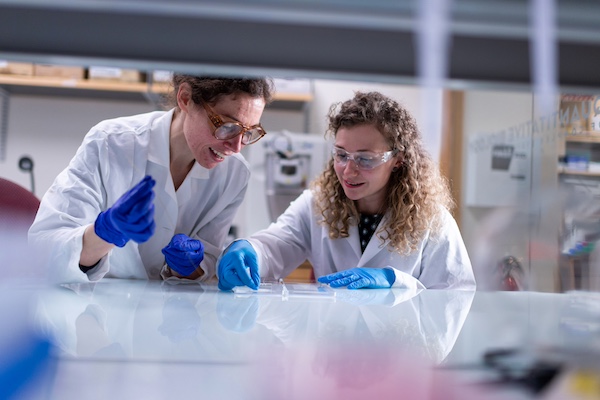Channeling a fascination with human biology
The exquisite complexity of the human body drew Marcela Tabima to science as a child and it keeps her laser focused on her regenerative biology work at both the Morgridge Institute for Research and the Wisconsin Institute for Discovery.
“Human biology always attracted me. Even as a little child, it commanded my attention because I think that it’s perfect, how the systems all work together,” says Tabima, the daughter of two Colombian economists. “I cannot learn enough about it.”
Since late 2023, she has worked as a principal scientist for WID’s CRISPR Vision program, where they are pushing the frontiers of gene editing technology to treat inherited retinal disease.
Prior to that, she was an associate scientist in the Morgridge’s Regenerative Biology Group. At Morgridge, she was deeply involved with translational stem cell research – specifically developing functional, stem cell-derived arteries for use in vascular surgery.
The lab is led by Professor Igor Slukvin, who took over the last two years of a seven-year National Institutes of Health grant for the artery project when stem cell pioneer James Thomson retired.
Tabima worked in a lab that has develops scaffolds from synthetic materials that give form and shape to the artery. Then, researchers use a bioreactor that enables endothelial and smooth muscle cells to grow naturally around the structure for use as small-diameter vascular grafts.
“If you just have a goal to get a Ph.D., that’s not enough. The goal is learning and gaining the tools you need to advance.”
Marcela Tabima
Advanced cardiovascular disease often results in people having blockages in the main arteries of their legs, which can lead to amputation or death. Ultimately, the project aims to develop an engineered artery bank that could be used to treat peripheral artery disease.
“We’re working in very innovative ways on methods that could affect the lives of many people,” Tabima says. “You need to be really persistent and meticulous to figure out ways to impact the patient. Dr. Thomson always asked, ‘If you needed it, would you put it in your leg?’”
She adds: “You have you ups and downs, and sometimes you ask, ‘Are we really moving in the right direction?’ But then you troubleshoot. You try a new method. You control a new variable. You need an open mind. I have a passion for this work.”
Tabima earned her undergraduate degree in chemical engineering in 2002 and a master’s in mechanical engineering from the Universidad de los Andes in Bogotá before using her Fulbright Scholarship to embark on a doctorate in biomedical engineering at UW–Madison.
She worked on tissue biomechanics with former UW–Madison Professor Naomi Chesler and did a postdoctoral stint at the University of Pittsburgh’s Vascular Medicine Institute. From there she returned to Colombia as an assistant engineering professor at Universidad de los Andes.
In 2015, she returned to Madison to work as an assistant scientist in Chesler’s lab for four years before finally joining the Thomson lab.
For students thinking of embarking on a scientific career, especially at the Ph.D. level, Tabima says they need to sharpen their focus, define their dreams and carefully set their goals.
“You need to have a purpose and a dream. Mine was the human body because I think it’s fabulous,” she says. “But make sure you know what the goal is and what it isn’t. If you just have a goal to get a Ph.D., that’s not enough. The goal is learning and gaining the tools you need to advance.”
In Colombia, Tabima says there is a national emphasis on churning out doctorates. But she sees academics through a wider lens.
“I’m not sure that’s the solution. We don’t need everyone doing a Ph.D. But we need everyone doing things that are going to solve problems in new and innovative ways,” she says.

Rising Sparks: Early Career Stars
Rising Sparks is a monthly profile series exploring the personal inspirations and professional goals of early-career scientists at the Morgridge Institute.

